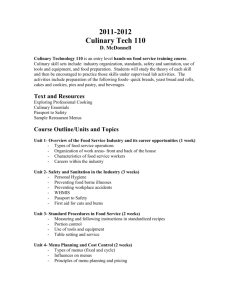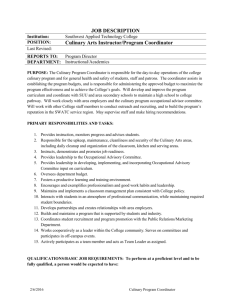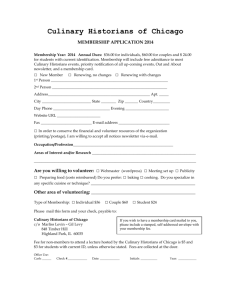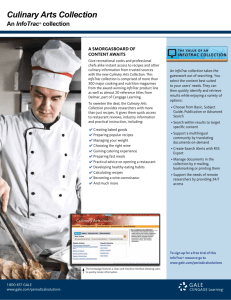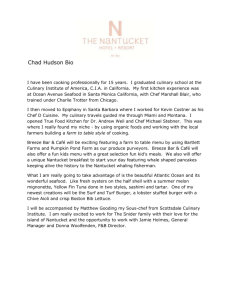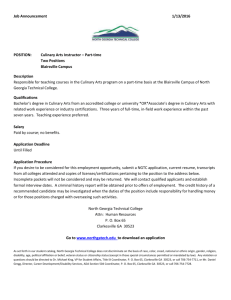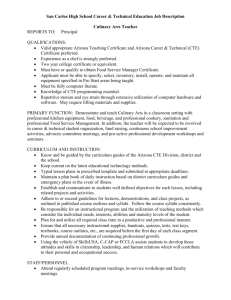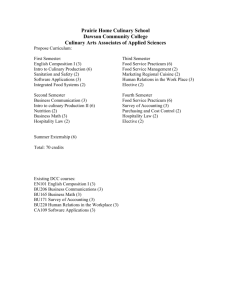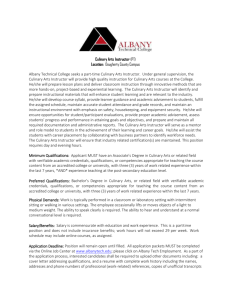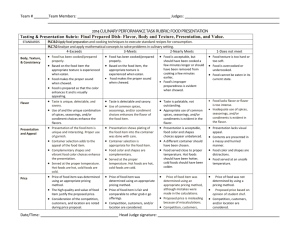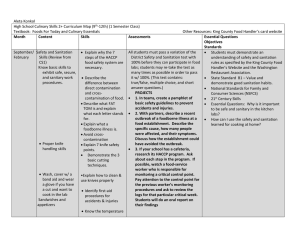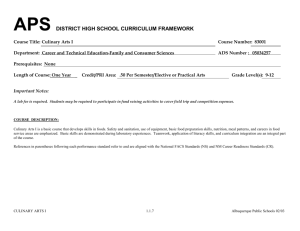Commercial Foods Blueprint
advertisement
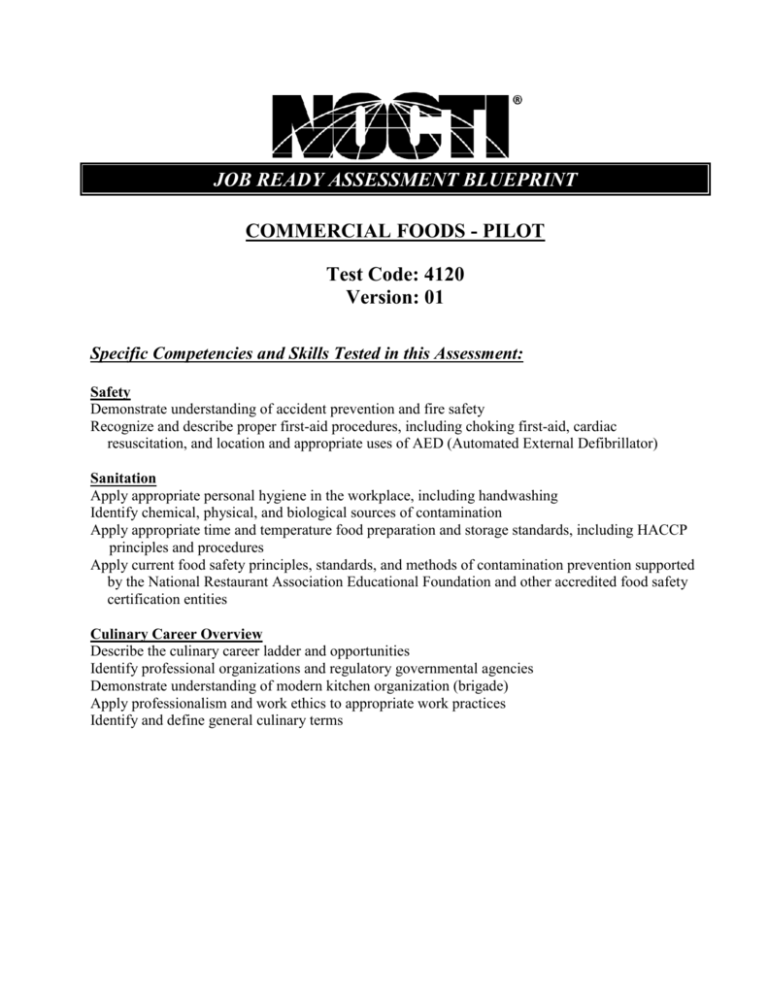
JOB READY ASSESSMENT BLUEPRINT COMMERCIAL FOODS - PILOT Test Code: 4120 Version: 01 Specific Competencies and Skills Tested in this Assessment: Safety Demonstrate understanding of accident prevention and fire safety Recognize and describe proper first-aid procedures, including choking first-aid, cardiac resuscitation, and location and appropriate uses of AED (Automated External Defibrillator) Sanitation Apply appropriate personal hygiene in the workplace, including handwashing Identify chemical, physical, and biological sources of contamination Apply appropriate time and temperature food preparation and storage standards, including HACCP principles and procedures Apply current food safety principles, standards, and methods of contamination prevention supported by the National Restaurant Association Educational Foundation and other accredited food safety certification entities Culinary Career Overview Describe the culinary career ladder and opportunities Identify professional organizations and regulatory governmental agencies Demonstrate understanding of modern kitchen organization (brigade) Apply professionalism and work ethics to appropriate work practices Identify and define general culinary terms Commercial Foods - PILOT (continued) Culinary Techniques Define and demonstrate various cooking methods Identify methods of flavor development, including herbs and spices Identify and prepare produce (including starches, legumes, and grains) Identify and prepare stocks, soups, and sauces Identify and prepare cold foods (including appetizers, salads, and salad dressings) Identify and prepare meats, poultry, and seafood Identify and prepare breakfast foods and dairy products (including eggs and batter items) Prepare desserts, pastry items, and baked goods Demonstrate appropriate knife handling skills and proper standard cuts Recipes and Culinary Math Read, convert, and prepare standardized recipes using correct equipment and tools Exhibit knowledge of appropriate portion control and plating Calculate food costs for recipes Demonstrate an understanding of weights, measures, equivalencies, and conversions Purchasing and Management Skills Demonstrate understanding of purchasing, receiving, and storage of perishable and non-perishable items Perform food and menu cost analysis Display familiarity with basic computer and inventory management systems Identify and describe basic management documents (e.g., requisitions, schedules, invoices) Menu Design and Nutrition Plan and design various types of menus, considering nutrition, cost, and specialized customer requests (i.e., local, regional, ethnic, organic) Display understanding of major food allergens and prevention of cross contamination Demonstrate understanding of federal nutritional guidelines Display familiarity with the “truth in menu” guidelines Customer and Table Service Describe the principles of providing good customer service, including greeting and basic sales techniques Define “front of the house” terminology Demonstrate proper table setup and service Identify, prepare and serve various beverages Perform guest check and cash handling, including computerized POS (point of service) Culinary Equipment Identify and select hand tools, utensils, and kitchen equipment Sharpen and maintain knives and utensils Exhibit safe operation, care, and sanitary maintenance of small and large equipment Commercial Foods – PILOT (continued) Written Assessment: Administration Time: Number of Questions: 3 hours 204 Areas Covered: 4% 10% 9% 26% 10% 10% 12% 10% 9% Safety Sanitation Culinary Career Overview Culinary Techniques Recipes and Culinary Math Purchasing and Management Skills Menu Design and Nutrition Customer and Table Service Culinary Equipment Sample Questions: A food-borne illness that is usually transmitted by under-cooked ground beef is A. cold virus B. streptococcus C. E. coli D. hepatitis C The universal sign for choking is hands to the A. chest B. heart C. throat D. mouth The entry level position in the food service industry is a/an A. chef B. sous chef C. dishwasher D. assistant buyer The correct order for breading food items A. egg wash, crumbs, then flour B. flour, crumbs, then egg wash C. flour, egg wash, then crumbs D. crumbs, egg wash, then flour A number 16 scoop holds 16 portions per A. cup B. quart C. gallon D. pound Commercial Foods - PILOT (continued) Products that are delivered damaged should be A. refused B. accepted C. donated D. discarded The most nutritional way to prepare vegetables is by A. sautéing B. boiling C. deep frying D. steaming The term “covers,” refers to A. co-workers B. vendors C. customers D. management An oven that uses forced hot air to cook food is a _____ oven. A. convection B. conventional C. microwave D. rotary When yeast forms carbon dioxide gas in a mixed dough, the action is called A. proofing B. emulsification C. fermentation D. kneading Commercial Foods - PILOT (continued) Performance Assessment: Administration Time: Number of Jobs: 3 hours and 5 minutes 3 Areas Covered: 13% Identification of Hand Tools, Herbs, Spices, and Flavorings Participants will identify a variety of items and record the name of each on the worksheet provided. 11% Knife Skills Participants will demonstrate proper knife skills using safety and sanitation to prepare a variety of vegetables and spices. 76% Cooking Skills Participants will prepare a four course meal using the recipes provided and follow standard sanitary guidelines. Steps to include place settings, meal preparation, and clean up. Sample Job: Identification of Hand Tools, Herbs, Spices, and Flavorings Maximum Job Time: 25 minutes Participant Activity: The participant is to identify items by writing the correct name of the item on the corresponding numbered line.
